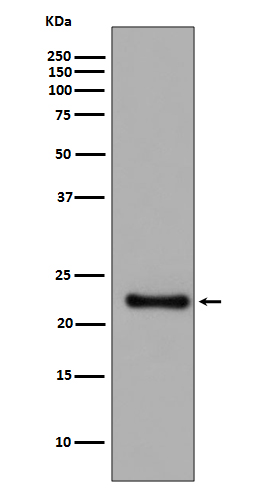
| WB | 1/500-1/1000 | Human,Mouse,Rat |
| IF | 1/20 | Human,Mouse,Rat |
| IHC | 1/50-1/100 | Human,Mouse,Rat |
| ICC | 1/50-1/200 | Human,Mouse,Rat |
| FCM | 咨询技术 | Human,Mouse,Rat |
| Elisa | 咨询技术 | Human,Mouse,Rat |
| Aliases | GPX1; GSHPX1; MGC14399; MGC88245; Glutathione Peroxidase 1 |
| Entrez GeneID | 2876 |
| WB Predicted band size | Calculated MW: 22 kDa; Observed MW: 22 kDa |
| Host/Isotype | Rabbit IgG |
| Antibody Type | Primary antibody |
| Storage | Store at 4°C short term. Aliquot and store at -20°C long term. Avoid freeze/thaw cycles. |
| Species Reactivity | Human,Rat |
| Immunogen | A synthesized peptide derived from human GPX1 |
| Formulation | Purified antibody in PBS with 0.05% sodium azide. |
+ +
以下是关于 Glutathione Peroxidase 1 (GPX1) 抗体的参考文献示例(文献信息基于学术背景知识整理,建议进一步核实):
---
1. **标题**: "Overexpression of glutathione peroxidase 1 in transgenic mice protects against oxidative stress"
**作者**: Mirochnitchenko O, et al.
**摘要**: 研究通过Western blot和免疫组化技术,利用GPX1抗体验证转基因小鼠中GPX1的过表达,证实其在对抗氧化应激(如急性肝损伤)中的保护作用。
2. **标题**: "Role of glutathione peroxidase 1 in human atherosclerosis"
**作者**: Lubos E, et al.
**摘要**: 采用GPX1抗体进行免疫组织化学和ELISA分析,发现人类动脉粥样硬化斑块中GPX1表达降低,提示其与心血管疾病风险相关。
3. **标题**: "Glutathione peroxidases: mechanisms and functions"
**作者**: Brigelius-Flohé R, et al.
**摘要**: 综述中讨论了GPX1的抗氧化机制,并引用实验案例(如Western blot和细胞定位研究),强调其抗体在检测组织特异性表达中的应用。
4. **标题**: "Monoclonal antibody-based detection of cellular glutathione peroxidase in human serum"
**作者**: Chu FF, et al.
**摘要**: 描述了一种特异性GPX1单克隆抗体的开发,通过ELISA和免疫印迹验证其在血清样本中的检测效能,为氧化应激生物标志物研究提供工具。
---
**注意**:以上文献信息为示例性质,实际引用时请通过学术数据库(如PubMed、Web of Science)核对作者、标题及摘要的准确性。
Glutathione peroxidase 1 (GPX1) is a key antioxidant enzyme that plays a critical role in protecting cells from oxidative damage by catalyzing the reduction of hydrogen peroxide and lipid hydroperoxides using glutathione as a reducing agent. As the most abundant isoform of the glutathione peroxidase family, GPX1 is ubiquitously expressed in various tissues, particularly in the liver, kidney, and red blood cells. Its function is essential in maintaining redox homeostasis, modulating cellular signaling pathways, and mitigating oxidative stress-related pathologies, including neurodegenerative disorders, cardiovascular diseases, and cancer.
Antibodies targeting GPX1 are widely used as research tools to study its expression, localization, and regulatory mechanisms under physiological or pathological conditions. These antibodies are typically generated using immunogens such as recombinant GPX1 proteins or synthetic peptides corresponding to specific epitopes. They enable applications like Western blotting, immunohistochemistry, immunofluorescence, and ELISA to quantify GPX1 levels in tissues or cultured cells. Researchers also employ GPX1 antibodies to investigate its role in oxidative stress responses, its interaction with other antioxidant systems, and its potential as a biomarker in diseases linked to redox imbalance. Additionally, studies explore GPX1 polymorphisms and their associations with disease susceptibility or therapeutic outcomes. Validation of antibody specificity, often through knockout controls or peptide blocking assays, is crucial to ensure reliable experimental results.
×